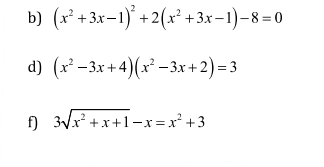phần c) ạ.Dạng bài giải pt vô tỉ bằng pp đặt ẩn phụ. p
p
Hãy nhập câu hỏi của bạn vào đây, nếu là tài khoản VIP, bạn sẽ được ưu tiên trả lời.


Lời giải:
Đặt $(x-3)^2=a$. Khi đó pt đã cho tương đương với:
$(x^2-6x+9-9)^2+13(x-3)^2-77=0$
$\Leftrightarrow [(x-3)^2-9]^2+13(x-3)^2-77=0$
$\Leftrightarrow (a-9)^2+13a-77=0$
$\Leftrightarrow a^2-5a+4=0$
$\Leftrightarrow (a-1)(a-4)=0$
$\Leftrightarroe a=1$ hoặc $a=4$
Đến đây thì đơn giản rồi.

ĐKXĐ:\(\left\{{}\begin{matrix}x\ne3\\y\ne1\end{matrix}\right.\)
Đặt `(x)/(x-3)` = a, `(y)/(y-1)` = b
\(\text{Hệ}\Leftrightarrow\left\{{}\begin{matrix}a+3b=5\\4a-b=7\end{matrix}\right.\\ \Leftrightarrow...\\ \Leftrightarrow\left\{{}\begin{matrix}a=2\\b=1\end{matrix}\right.\\ \Leftrightarrow\left\{{}\begin{matrix}\dfrac{x}{x-3}=2\\\dfrac{y}{y-1}=1\end{matrix}\right.\\ \Leftrightarrow\left\{{}\begin{matrix}x=2x-6\\y=y-1\end{matrix}\right.\\ \Leftrightarrow\left\{{}\begin{matrix}x=6\\-1=0\left(vô.lí\right)\end{matrix}\right.\)
Vậy hpt vô nghiệm

Đặt \(\sqrt{x^2+x+1}=a\)
Pt trở thành \(3a=a^2+2\)
=>(a-1)(a-2)=0
\(\Leftrightarrow\left\{{}\begin{matrix}x^2+x+1=1\\x^2+x+1=4\end{matrix}\right.\Leftrightarrow\left\{{}\begin{matrix}x^2+x=0\\\left(x+\dfrac{1}{2}\right)^2=\dfrac{13}{4}\end{matrix}\right.\)
\(\Leftrightarrow x\in\left\{0;-1;\dfrac{\sqrt{13}-1}{2};\dfrac{-\sqrt{13}-1}{2}\right\}\)

b: \(\Leftrightarrow\left(x^2+3x-1\right)^2+4\left(x^2+3x-1\right)-2\left(x^2+3x-1\right)-8=0\)
\(\Leftrightarrow\left(x^2+3x-1\right)\left(x^2+3x-1+4\right)-2\left(x^2+3x-1+4\right)=0\)
\(\Leftrightarrow x^2+3x-3=0\)
\(\Delta=3^2-4\cdot1\cdot\left(-3\right)=9+12=21>0\)
Do đó: Phương trình có hai nghiệm phân biệt là:
\(\left\{{}\begin{matrix}x_1=\dfrac{-3-\sqrt{21}}{2}\\x_2=\dfrac{-3+\sqrt{21}}{2}\end{matrix}\right.\)
d: \(\Leftrightarrow\left(x^2-3x\right)^2+6\left(x^2-3x\right)+8=3\)
\(\Leftrightarrow\left(x^2-3x\right)^2+5\left(x^2-3x\right)+\left(x^2-3x\right)+5=0\)
\(\Leftrightarrow x^2-3x+1=0\)
\(\Delta=\left(-3\right)^2-4\cdot1\cdot1=5>0\)
Do đó: Phương trình có hai nghiệm phân biệt là:
\(\left\{{}\begin{matrix}x_1=\dfrac{3-\sqrt{5}}{2}\\x_2=\dfrac{3+\sqrt{5}}{2}\end{matrix}\right.\)



Lời giải:
Đặt $\sqrt[3]{2x+1}=a; \sqrt[3]{x}=b$ thì ta có:
$a+b=1$ và $a^3-2b^3=1$
$\Rightarrow a^3-2b^3=(a+b)^3$
$\Leftrightarrow a^3-2b^3=a^3+3a^2b+3ab^2+b^3$
$\Leftrightarrow 3a^2b+3ab^2+3b^3=0$
$\Leftrightarrow b(a^2+ab+b^2)=0$
$\Leftrightarrow b=0$ hoặc $a^2+ab+b^2=0$
Nếu $b=0\Leftrightarrow \sqrt[3]{x}=0\Leftrightarrow x=0$ (thử lại thấy tm)
Nếu $a^2+ab+b^2=0$
$\Leftrightarrow (a+\frac{b}{2})^2+\frac{3}{4}b^2=0$
$\Rightarrow a+\frac{b}{2}=b=0$
$\Rightarrow a=b=0$
$\Leftrightarrow \sqrt[3]{2x+1}=\sqrt[3]{x}=0$
$\Leftrightarrow x=\frac{-1}{2}=0$ (vô lý)
Vậy $x=0$